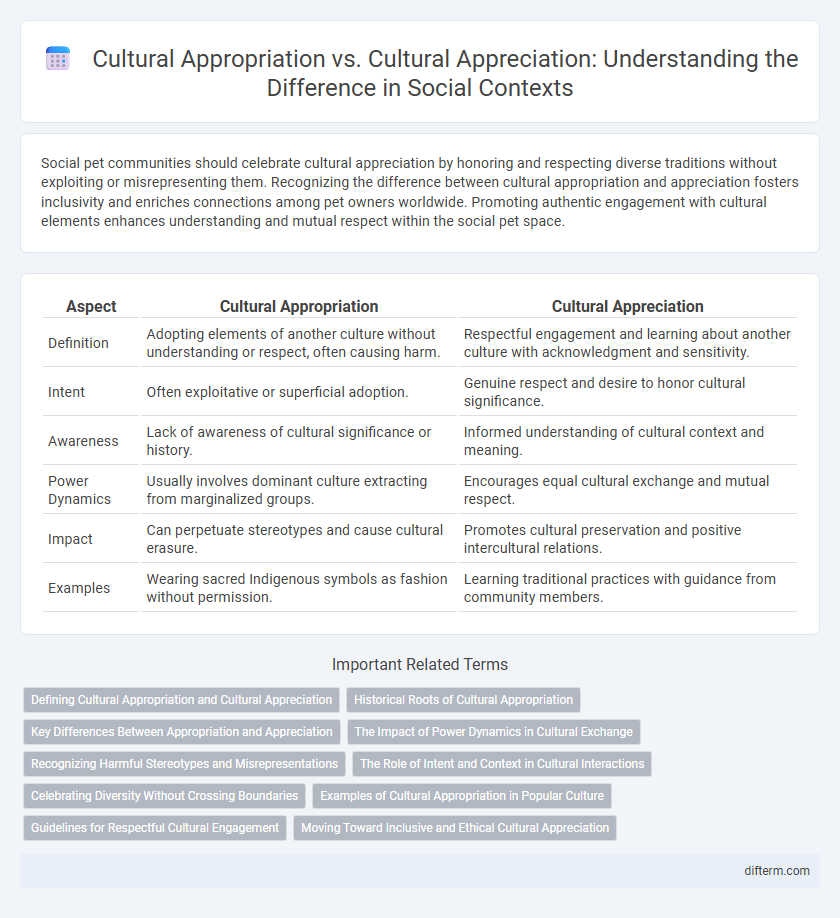Social pet communities should celebrate cultural appreciation by honoring and respecting diverse traditions without exploiting or misrepresenting them. Recognizing the difference between cultural appropriation and appreciation fosters inclusivity and enriches connections among pet owners worldwide. Promoting authentic engagement with cultural elements enhances understanding and mutual respect within the social pet space.
Table of Comparison
| Aspect | Cultural Appropriation | Cultural Appreciation |
|---|---|---|
| Definition | Adopting elements of another culture without understanding or respect, often causing harm. | Respectful engagement and learning about another culture with acknowledgment and sensitivity. |
| Intent | Often exploitative or superficial adoption. | Genuine respect and desire to honor cultural significance. |
| Awareness | Lack of awareness of cultural significance or history. | Informed understanding of cultural context and meaning. |
| Power Dynamics | Usually involves dominant culture extracting from marginalized groups. | Encourages equal cultural exchange and mutual respect. |
| Impact | Can perpetuate stereotypes and cause cultural erasure. | Promotes cultural preservation and positive intercultural relations. |
| Examples | Wearing sacred Indigenous symbols as fashion without permission. | Learning traditional practices with guidance from community members. |
Defining Cultural Appropriation and Cultural Appreciation
Cultural appropriation involves adopting elements of a marginalized culture without understanding or respecting its significance, often leading to misrepresentation and exploitation. Cultural appreciation, by contrast, entails actively learning about and honoring the traditions, values, and history behind cultural practices with permission and sensitivity. Recognizing this distinction is essential for fostering respectful intercultural interactions and promoting inclusivity.
Historical Roots of Cultural Appropriation
Cultural appropriation has deep historical roots tied to colonialism and power imbalances, where dominant groups adopted elements from marginalized cultures without permission or understanding. Indigenous designs, traditional garments, and sacred symbols were often exploited, stripping their original meaning and significance. Recognizing this history is essential to distinguish cultural appreciation, which involves respectful learning and honoring of cultural practices.
Key Differences Between Appropriation and Appreciation
Cultural appropriation involves adopting elements of a marginalized culture without understanding or respecting its significance, often perpetuating stereotypes and power imbalances. In contrast, cultural appreciation requires intentional learning, respectful engagement, and acknowledgment of the culture's origins and meanings. Key differences include the presence of consent, context of usage, and the impact on the source community's dignity and identity.
The Impact of Power Dynamics in Cultural Exchange
Power dynamics significantly influence cultural exchange, often determining whether interactions are seen as cultural appropriation or cultural appreciation. When dominant groups adopt elements from marginalized cultures without permission or understanding, it perpetuates inequality and cultural exploitation. Respectful cultural appreciation requires acknowledging historical context, power imbalances, and actively promoting equitable exchange.
Recognizing Harmful Stereotypes and Misrepresentations
Recognizing harmful stereotypes and misrepresentations is crucial in distinguishing cultural appropriation from cultural appreciation, as appropriation often reinforces inaccurate or offensive portrayals of marginalized communities. Cultural appreciation involves respectful engagement and accurate representation, which helps preserve the integrity and richness of cultural traditions without distorting their meaning. Addressing these issues requires awareness and education to prevent perpetuating harmful narratives that contribute to social inequality.
The Role of Intent and Context in Cultural Interactions
The role of intent and context in cultural interactions is pivotal in distinguishing cultural appreciation from cultural appropriation, where genuine respect and understanding foster positive exchange, while exploitation or insensitivity leads to harm. Intent grounded in education, collaboration, and acknowledgment of cultural significance promotes meaningful appreciation, especially when power imbalances and historical oppression are considered. Contextual awareness includes recognizing the cultural origin, consulting community members, and honoring traditions, thereby preventing misrepresentation and preserving cultural integrity.
Celebrating Diversity Without Crossing Boundaries
Honoring cultural traditions through appreciation involves respectfully engaging with customs by learning their historical significance and supporting authentic voices within the community. Distinguishing appreciation from appropriation requires awareness of power dynamics and avoiding commodification or misrepresentation of sacred symbols. Embracing diversity responsibly fosters mutual respect while preserving cultural integrity and promoting inclusive dialogue.
Examples of Cultural Appropriation in Popular Culture
Instances of cultural appropriation in popular culture include fashion brands using Indigenous patterns without permission, music artists adopting traditional hairstyles like dreadlocks or cornrows without understanding their cultural significance, and Halloween costumes that stereotype ethnic dress. Celebrities wearing sacred symbols as mere accessories also exemplify this trend, sparking backlash from the represented communities. These actions often contribute to cultural misrepresentation and the commodification of marginalized cultures.
Guidelines for Respectful Cultural Engagement
Respectful cultural engagement requires understanding the distinction between cultural appreciation and appropriation by prioritizing consent, context, and cultural significance. Engage with communities through education, active listening, and acknowledging the origins and contributions of cultural expressions to avoid misrepresentation. Supporting authentic voices and promoting cultural exchange fosters respect and inclusivity while preventing exploitation or stereotyping.
Moving Toward Inclusive and Ethical Cultural Appreciation
Moving toward inclusive and ethical cultural appreciation involves recognizing the origins and significance of cultural elements while respecting the communities they stem from. Emphasizing collaboration with cultural representatives fosters mutual understanding and helps avoid exploitation or misrepresentation. Prioritizing education and open dialogue strengthens respectful engagement and supports the celebration of diverse cultures without appropriation.
cultural appropriation vs cultural appreciation Infographic

 difterm.com
difterm.com